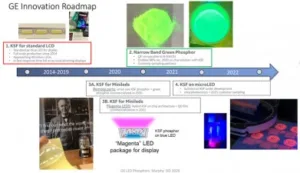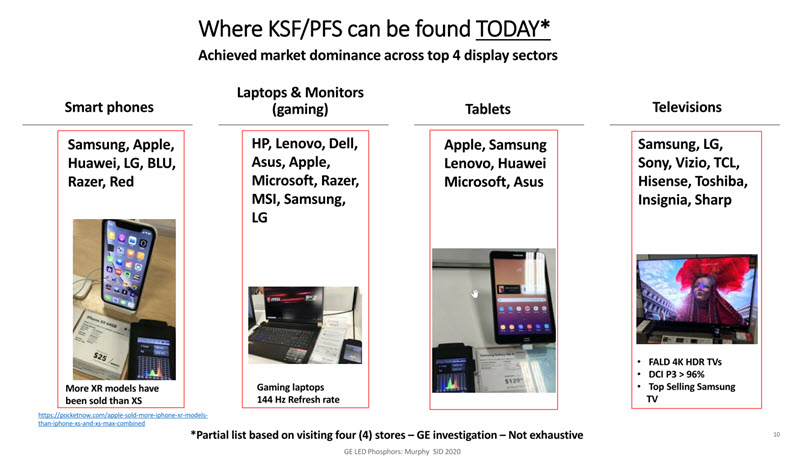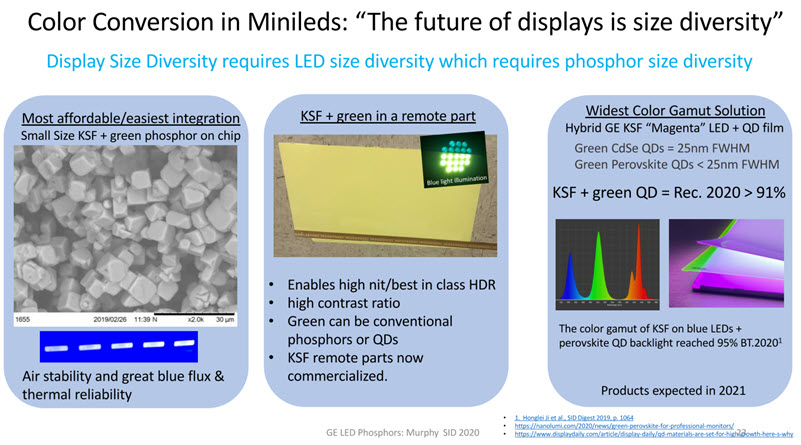When, during last week’s SID Display Week Business Conference, Jason Hartlove of Nanosys declared that the battle between OLED and QD-enhanced TVs was over. Although there was some logic to the point of view, it sounded just a touch hubristic (if that’s a word!). It sounded especially so after the talk by James Murphy of GE about the developments in its phosphor business.

We’ve been reporting on KSF since 2015 (it started production in 2014) and I wrote a Display Daily about it in 2017 (There’s More than One Way to Make a WCG LCD) and we have returned to the subject several times since.
(for new readers, KSF is a narrow band red phosphor that is used to create WCG LEDs that is combined with green phosphors to create much wider gamut displays from blue LEDs than the ‘traditional’ broadband YAG white phosphors).
Murphy highlighted the success of KSF (also known as PFS) phosphors and said in his talk that KSF has been used now in 40 billion LEDs. Of course, that doesn’t mean 40 billion displays, as multiple LEDs are used in backlights, but it does mean a lot of displays. It is also used in a lot of leading products and Murphy pointed out that the best selling Samsung TV model this year uses KSF rather than QDs. (GE doesn’t need to track who uses what via the supply chain. Just measuring the colours emitted by the screens in stores shows up the very characteristic colour profile – editor).
So, red has been a great success for GE, but to get wide gamuts, you really need a good green as well, so GE has developed a new green material that is said to be as efficient as current B-SiALON phosphors, but enables narrow band emission to allow support of 88% of Rec. 2020 gamuts. The firm has developed a film of KSF + Green phosphor to be used for miniLED backlights to create white. (miniLED backlights are a hot topic at the moment, especially for the Taiwanese makers who are not able to easily get into the OLED business – editor)
Murphy also highlighted the idea of a ‘Magenta LED’ concept (previously described in a Display Daily by Sid Mohan (QD Materials are Set for High Growth – Here’s Why). The LED emits blue and adds red with the KSF material put directly on the LED itself. The light from the LED can then be combined with materials that cannot be used on chip, such as green QDs. Murphy said that Perovskite-based Green QDs are making good progress in this application. The approach can produce higher brightness and better efficiency than other approaches, Mohan has said, and that’s a real advantage.
MicroLED has been a very hot topic for the industry, but a making them has been a real challenge. My view has been that colour conversion is almost certainly the way that microLED will become successful because of the difficulties if you try to use different LED architectures for different colours. However, to be really competitive, that colour conversion really needs to be on the LED itself, not remote (like QDEF quantum dots). Up to now, the QDs could not stand the temperature and high flux from being so close to the LEDs, while phosphor particles were too big for really small microLEDs.
QD companies are trying to overcome their challenges, but so are the phosphor makers and Murphy said that GE has developed submicron KSF materials that can be used for red creation directly on microLEDs. The company also has inks and photo resists for different deposition processes and he said that customer sampling is expected in 2021.
A Revolution in Phosphors
Although there has been lots of talk about QD and OLEDs, there has been a real revolution in phosphors, Murphy continued. Generation 1 had very broad emission and the key development was the use of YAG phosphors to create white LEDs, before 2012. You can make good colours this way, but you have to filter the light heavily to get pure colours and that reduces efficiency. The YAG devices also produce a lot of near infrared which reduces brightness and is wasted energy.
By 2015, the third generation used more narrow band phosphors, which usually had KSF for the red. Filtering could be reduced and less light is produced in areas where the eye really can’t see it.
PFS/KSF has five peak emissions at 609, 613, 631, 635 and 649 nanometres with <2nm FWHM. That gives good enough red for DCI-P3 matching as well as meeting Rec 2020 for red. It can handle high temperatures and high flux requirements so can be used on chip and does not require encapsulation as it is stable in air. That meant relatively easy adoption from generation two designs. The phosphor use has to be licensed with GE.
The technology is available in all sectors and applications where a wide gamut is wanted, in mobile or fixed applications. Lots of high selling TVs with WCG have KSF phosphors. In monitors, KSF-enabled panels are getting to 100% of DCI-P3.
Next generation KSF is improving in particle size, absorption, high temperature and humidity reliability and has made a big boost in water exposure. It has even been tested when dunked in water, which can make some processing stages easier. It is also been improved to work better in different films.
Green for the Future
Looking to the future, there is a new narrow band green phosphor.
Murphy said that the red emission is narrower than the InP QDs currently available in the market and used in the US. QDs can be tuned, but as you push beyond 630nm you may have too many issues with efficiency and that is a challenge with the move to HDR. KSF can also cover more of the Rec. 2020 red area than QDs.
The main green phosphor at the moment is B-SiALON, which is efficient but has a ‘tail’ which goes into the red and moves the red point back towards smaller gamuts. Going more narrow band eliminates that issue and GE has a new green that can produce 100% of DCI-P3, 100% of AdobeRGB and enables 88% of Rec 2020 when used with KSF. The material can be used on-chip, so you need less material than with ‘remote parts’ (e.g. QDs – editor).
Murphy said that the success of display technologies is in display size diversity. The technologies that win can work in all sizes, big and small. That’s also true in phosphors for different sizes of LEDs. As the LEDs get smaller, the particles of phosphor need to get smaller. KSF can maintain 90% conversion, but can be mixed with green phosphor and used on chip. That is the lowest cost and easiest integration process for miniLEDs.
You could also combine KSF with a green material that might need to be remote (such as QDs or sensitive phosphors) for very high brightness or high contrast applications. Murphy thinks there will be a number of application in the market with this configuration.
The widest gamut solution is to use a Magenta LED (blue LED + KSF) and a narrow green QD film (CsSe with 25nm FWHM or Perovskite with <25nm FWHM). This architecture can achieve from 91% to 95% of Rec 2020 gamut. Murphy quoted Perovskite data from Nanolumi (there are others) and also said that products are likely to be in markets by 2021.
Murphy turned then to ‘the Holy Grail’. KSF has penetrated very well, but could it get to the levels needed for microLED? Phosphors for microLED have to absorb all the blue light and that is a real challenged, but KSF has been modified to increase the manganese content, a factor that helps with blue absorption. The materials are air stable and need no encapsulant and have been developed into spin coated films. However, GE has also been able to inkjet print the material which might be a good way to deposit them.
Are we there yet? Not quite, said Murphy, but the company hopes to get to sampling by 2021. Ideally, the company will get down to around 30 microns feature size using inkjet printing techniques. (BR)




